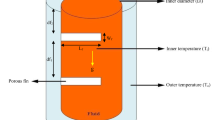Abstract
A simple mathematical model of fluid flow in a common type of scraped-surface heat exchanger in which the gaps between the blades and the device walls are narrow, so that a lubrication-theory description of the flow is valid, is presented. Specifically steady isothermal flow of a Newtonian fluid around a periodic array of pivoted scraper blades in a channel with one stationary and one moving wall, when there is an applied pressure gradient in a direction perpendicular to the wall motion, is analysed. The flow is three-dimensional, but decomposes naturally into a two-dimensional “transverse” flow driven by the boundary motion and a “longitudinal” pressure-driven flow. First details of the structure of the transverse flow are derived, and, in particular, the equilibrium positions of the blades are calculated. It is shown that the desired contact between blades and the moving wall will be attained, provided that the blades are pivoted sufficiently close to their ends. When the desired contact is achieved, the model predicts that the forces and torques on the blades are singular, and so the model is generalised to include three additional physical effects, namely non-Newtonian power-law behaviour, slip at rigid boundaries, and cavitation in regions of very low pressure, each of which is shown to resolve these singularities. Lastly the nature of the longitudinal flow is discussed.
Similar content being viewed by others
References
Stranzinger M, Feigl K, Windhab E (2001) Non-Newtonian flow behaviour in narrow annular gap reactors. Chem Eng Sci 56:3347–3363
Fitt AD, Please CP (2001) Asymptotic analysis of the flow of shear-thinning foodstuffs in annular scraped heat exchangers. J Eng Math 39:345–366
Sun K-H, Pyle DL, Fitt AD, Please CP, Baines M, Hall-Taylor N (2003) Numerical study of 2D heat transfer in a scraped surface heat exchanger. Comp Fluids 33:869–880
Härröd M (1990) Methods to distinguish between laminar and vortical flow in scraped surface heat exchangers. J Food Proc Eng 13:39–57
Wang W, Walton JH, McCarthy KL (1999) Flow profiles of power law fluids in scraped surface heat exchanger geometry using MRI. J Food Proc Eng 22:11–27
Rodruiguez S (2000) Flow measurements in scraped surface heat exchangers. PhD thesis, University of Birmingham, UK
Härröd M (1986) Scraped surface heat exchangers: a literature survey of flow patterns, mixing effects, residence time distribution, heat transfer and power requirements. J Food Proc Eng 9:1–62
Rao CS, Hartel RW (2006) Scraped surface heat exchangers. Crit Rev Food Sci Nutr 46:207–219
Practical mathematical models for scraped surface heat exchangers. Math Today 42:124–125 (2006)
Fitt AD, Lee MEM, Please CP (2006) Analysis of heat flow and “channelling” in a scraped surface heat exchanger. To appear J Eng Math
Ho C-H, Tai Y-C (1998) Micro-electro-mechanical systems (MEMS) and fluid flows. Ann Rev Fluid Mech 30:579–612
Kaajakari V, Lal A (2003) Thermokinetic actuation for batch assembly of microscale hinged structures. J Microelectromech Syst 12:425–432
Peskin CS (1982) The fluid dynamics of heart valves: experimental, theoretical, and computational methods. Ann Rev Fluid Mech 14:235–259
Penney WR (2002) Agitated vessels. In: Hewitt GF (ed) The heat exchanger design handbook. Begell House, New York
Raimondi AA, Boyd J (1955) Applying bearing theory to the analysis and design of pad-type bearings. Trans ASME 77:287–309
Raimondi AA, Boyd J (1955) The influence of surface profile on the load capacity of thrust bearings with centrally pivoted pads. Trans. ASME 77:321–330
Silliman WJ, Scriven LE (1978) Slip of liquid inside a channel exit. Phys Fluids 21:2115–2116
Weidner DE, Schwartz LW (1994) Contact-line motion of shear-thinning liquids. Phys Fluids 6:3535–3538
Johnson MW, Mangkoesoebroto S (1993) Analysis of lubrication theory for the power law fluid. Trans ASME J Tribol 115:71–77
Ross AB, Wilson SK, Duffy BR (1999) Blade coating of a power-law fluid. Phys Fluids 11:958–970
Greenspan HP (1978) On the motion of a small viscous droplet that wets a surface. J Fluid Mech 84:125–143
Hocking LM (1981) Sliding and spreading of thin two-dimensional drops. Q J Mech Appl Math 34:37–55
Szeri AZ (1998) Fluid film lubrication: theory and design. Cambridge
Author information
Authors and Affiliations
Corresponding author
Rights and permissions
About this article
Cite this article
Duffy, B.R., Wilson, S.K. & Lee, M.E.M. A mathematical model of fluid flow in a scraped-surface heat exchanger. J Eng Math 57, 381–405 (2007). https://doi.org/10.1007/s10665-006-9116-4
Received:
Accepted:
Published:
Issue Date:
DOI: https://doi.org/10.1007/s10665-006-9116-4




